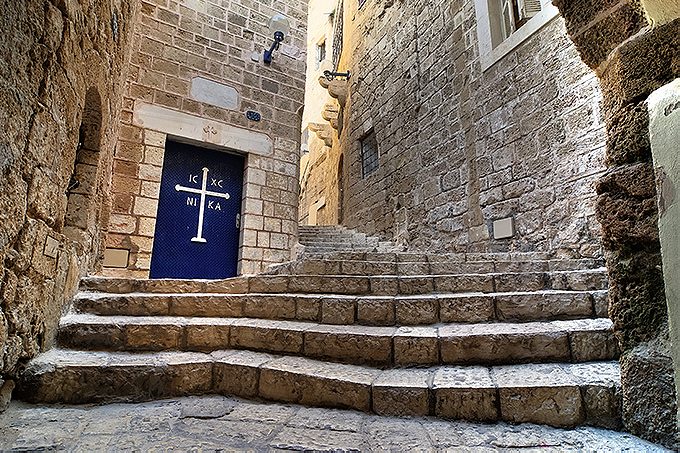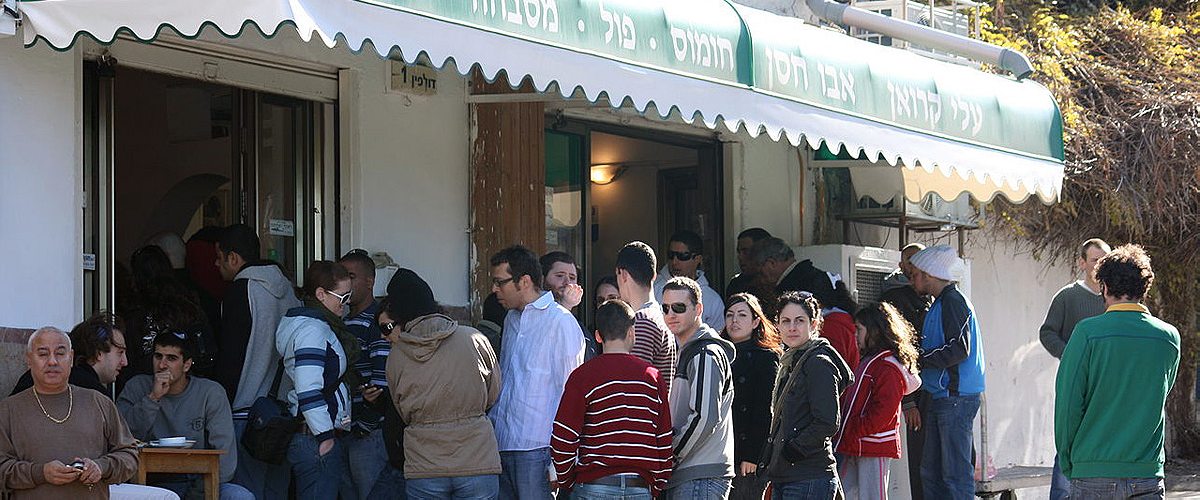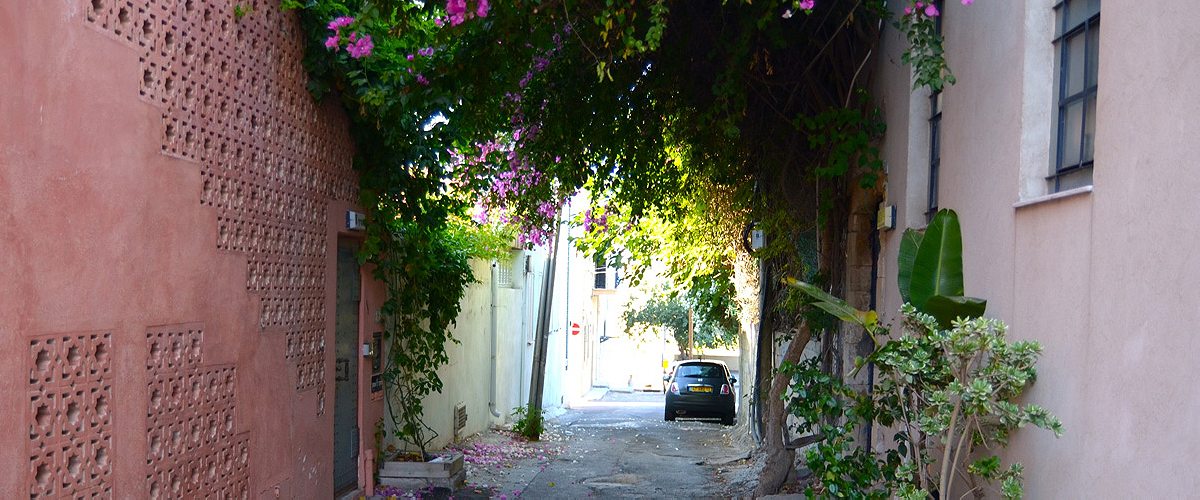Abu Hassan serves legendary hummus in a country that worships the dish.
Take a walk on the bustling beachfront promenade of Tel Aviv and your eye will inevitably be drawn south, to the cascading pale stone walls of Jaffa’s old town. Built high on a rock and a few millennia older than anything around it, Jaffa is a peculiar place, blessed and cursed to be at a crossroads of cultures: a historic, once-Arab port town now swallowed up by the young Euro-Jewish hybrid of Tel Aviv, an oasis of crumbling stone mansions and cobbled streets within a city of skyscrapers and seaside rollerblading.
It is unquestionably Israel, but somehow, the flavour of its otherness clings on — in the broad-hulled fishing boats that bring in the morning catch under escort of seagulls, the candy-coloured Coptic church, the chatter tumbling off communal balconies, the bougainvillea-shaded courtyards that magically appear when, dazed by the white heat, you take yet another wrong turn in the maze of its streets.

Gentrification is moving fast in Jaffa, both relentless and politically significant: Palestinian families are steadily supplanted by Israeli hipster couples, metalwork yards and weaving shops close down to be replaced by delis, off-beat designer boutiques and wine bars. In many ways, the town’s history reflects the course of Israel itself: a contested geographical space with ancient beginnings that has become a frontline for demographic and cultural politics between Arabs and Jews. A place always in flux, never at peace.
Yet for me, and for many Israelis walking with purpose towards the beaconing tower of St Peter’s Church, politics is irrelevant: Jaffa is not a battleground for hearts and minds, but a battleground for stomachs, and the weapon of choice is hummus.
Smooth and comforting on the palate and the perfect blend of savoury and creamy, hummus simply means ‘chickpea’ in Arabic. Some form of pureed chickpeas has been eaten by the Arabs in the region covered by present-day Syria, Lebanon and Israel for centuries — and living alongside them, the Mizrahi Jews also had hummus on their tables in Aleppo, Damascus and Beirut. When they came to their new homeland in the late 1940s, they brought it with them, its favorable price-to-protein ratio and kosher credentials making it a natural favourite for the motley groups coming together to build a new nation. While in its Arab neighbours hummus comes as a side dish even late into the night, in Israel it became a main course to be had early, substantial enough to set you up for the long day ahead.
Israelis consider hummus a national dish.
Israelis now consume more hummus per capita than any other nation in the world: they consider it their national dish, and those who feel very strongly about its Jewishness are even digging into biblical texts to put forward their own claim to its creation back in the mists of time.
The disputed ownership of hummus, as well as the verdict on who makes the definitive version, have inspired countless internet feuds and polemic articles (including one of Wikipedia’s most absurd edit wars, two serious documentaries (‘Make Hummus not War’ and ‘The Hummus Wars’), one spoof short film (‘The Hummus Enforcement Agency’), as well as the race for the Guinness World Record crown, currently alternating between Lebanon and a Palestinian village in Israel.
There are hundreds of recipes, some dogmatically orthodox in their simplicity, others pushing the limits of fusion and good taste with flourishes like sundried tomatoes, beetroot and wasabi. There’s even been an attempt at an ice cream incarnation, as part of the rotating specials at Israel’s Leggenda gelato parlours. (Spoiler: they’ve skipped the garlic and added honey, producing a taste similar to caramelised halva. I was less than impressed.)

With hundreds of recipes come also a thousand opinions about what exactly it is that makes great hummus. Maybe it’s the flavour (heavy or light lemon, raw or roasted garlic, smooth or spicy olive oil?). Or maybe it’s the consistency (thin for easy scooping, thick like cold honey or chunky enough to make an unmoving mound on the plate?).
Possibly the secret is in the preparation (hand-cranked food mill or blender, shell the chickpeas or leave them whole?). Or maybe it’s in the presentation (warm or room temperature, sprinkled with spices on top or mixed in lightly at last minute?). Even after it reaches the table, debate on ‘the best’ way to scoop it with your pita bread (from the middle of the plate out like a tidal wave, or from the rim of the plate down and around like a maelstrom?) is enough to get a table of housewives shouting each other down in indignation.
Like every religion, hummus needs its temples.
The endless arguments on chickpea dogma make hummus a religious issue in Israel — and like every religion, it too needs its temples. Like the Brits have the chippy and the Germans the Wurstbude, the Israelis have the “hummusia”, essentially a cantine selling hummus in tubs to take home or serving it to eat right there, in bare-bones surroundings, on rickety tables crammed next to fellow devotees regardless of class, race, colour or creed — Jew next to Arab, banker next to biker. A hummusia opens for that sweet, slow time of the morning between breakfast and early lunch, and closes just after noon, when the hummus pot is empty.
“Jews…and even more specifically Jewish men, never tire of arguments about the absolute, the only and only, the most fantastic hummusia,” Yotam Ottolenghi and Sami Tamimi wrote in the hugely popular Jerusalem: A Cookbook, where hummus takes up eight of the book’s 300 pages. “The hummusia fetish is so powerful that even the best of friends may easily turn against each other if they suddenly find themselves in opposite hummus camps.”
To capture that elusive quality of greatness, a hummusia will often serve a special ‘classic’, accepted variation or combination of hummus next to the original.
Those that I’ve tried so far at various corners of the Syria-Lebanon-Israel hummus heartlands include, in no particular order of preference:
hummus kawarma: sauteed chunks of ground beef or lamb scented with allspice, za’atar or cinnamon)
hummus b’lahmeh a daintier version of kawarma, with same spicing but the meat is minced.
sucuklu hummus: the slightly more heart-stopping one, spotted in Turkey and Israel, featuring blitz-fried slices of the Turko-Armenian air-dried sausage called sucuk (pronounced su-djuk)
hummus ful: topped with a thin stew of cooked broad beans of a deep oxblood colour. In Israel, the addition of a hardboiled egg on top makes hummus ful the protein Armageddon of “hummus-ful-beitza“—what the Israelis call komplet. (You’ll be komplet for about a day after one of them)
hummus beiruti: a no-garlic version more common among the Syrians, it features a generous handful of chopped parsley mixed in before serving.
hummus bi zeit: made with olive oil instead of tahini, it is lighter and more peppery
hummus bel snoobar: topped with pine nuts that are first toasted and then finished in clarified butter
hummus Khawali: named after the Damascus restaurant that first served it, probably the most far-out of the classic hummus dishes: pale pink, it incorporates muhammara red pepper paste and pomegranate molasses for a spicy-sweet-tangy top note over the creaminess of the chickpea.

The mental checklist alone brings back that warm feeling of a carbohydrate coma, but it’s the thought of a new addition to it that makes my heart flutter. I am about to try something that is a bit like hummus, but even better than hummus, or rather the next dimension of it: m’sabbha (also spelled masabcha, msabbha, masubha, messabha and probably a dozen other ways, depending on where you are), a dish of softly-cooked chickpeas floating gently in a sea of hummus, thinned tahini, olive oil and spices, served hot.

For a taste of m’sabbha, I am going straight to the source, along the steep path uphill in an unassuming Jaffa neighbourhood. There are several well-known hummus joints in other places in Israel — in Jerusalem and Akko, most run by Palestinian families — but the beating heart of the chickpea cult is here, under the worn flagstones of this ancient town. And while Jaffa boasts dozens of contenders in stiff competition, they all bow to the power of one name: Abu Hassan.
Abu Hassan was the patriarch of a family that has been in the hummus business since the 1950s, when he started on the path to world domination armed only with a pushcart and his wife’s talent in the kitchen. His name was Ali, but as per Palestinian custom he was called by the honorific ‘Abu’, i.e. ‘father of Hassan’ – the family’s eldest son and current head of the business. Ali died in 2007 but a charcoal etching of his lean, noble face still presides over the original branch on Ha’Dolphin street, surveying the chaos of the cramped dining room with soulful, deep-set eyes.
Israelis are not big on waiting in line (and that’s putting it kindly), but people don’t seem to mind queuing outside Abu Hassan, spilling around the corner and down the little hill to the roundabout — all for a taste of ‘the best hummus in Jaffa’, which to them just as well means ‘the best hummus in the world’.
They queue and eye with envy those too sly or impatient to wait for a table, who just grabbed their loot from the tiny takeaway window and sat down on door stoops and fence edges along the street with their plastic tubs and handfuls of pita, content like cats in the sunshine.
“I’ve been coming here for 30 years, from back when Abu Hassan was still alive and running around the place,” says taxi-driver Josef Gabbi, 57, who polished off his daily fix already at around 10 in the morning. “And they never once got it wrong.”

“They’ve opened two more branches now, nearby, but here in this tiny place with all the pushing and the shouting of the orders and the commotion, it tastes the best. I don’t know if it’s that it’s so fresh, if they cook it a certain way, or they have a secret ingredient, I don’t know,” he adds, growing animated.
“I’ve eaten hummus all over the place, in Tel Aviv, Jerusalem, all over Israel. I even had it in Lebanon during the war. Most are good, some are great, but still when you compare them to Abu Hassan they don’t even come close. And if you think their hummus is so good, then, ah, the m’sabbha, the m’sabbha, now that is the breakfast of champions.”
M’sabbha: warm creaminess lit up by iridescent slicks of olive oil.
I sit down with my co-tester, an intrepid German who’s eaten enough legumes to last ten lifetimes through his work in the Balkans and Africa. We order a round of “everything you got on the menu”, and within minutes, I have a steaming bowl of m’sabbha in front of me. It’s all pale, warm creaminess lit up by iridescent slicks of olive oil, the colours of the Jaffa fortress in the sunlight. The chickpeas lurk beneath the surface, looking a bit like children’s book drawings of crocodiles in a river, here and there peeking under specks of parsley and dustings of spice.
At Abu Hassan, m’sabbha is served with wedges of raw onion, pickles and pita bread still warm from the oven, plus a small saucer of tatbila: a hot-sour sauce of garlic, lemon juice and chopped-up pickled peppers that cuts perfectly through the creaminess of the dish. I tear off a corner of the pita, dip it in the tatbila, and then in the m’sabbha. The first mouthful blasts its way past my taste buds and right there, over the din of the waiters’ voices and the clatter of porcelain on Formica, I feel the ecstasy of conversion.
It takes but a bite for me to understand the m’sabbah obsession. The taste is more complex than plain old hummus, the textures more evolved: silky tahini blends with velvety hummus and the brilliant sheen of the olive oil, the perfect cushion for the barely-there bite of the whole chickpeas. They perch daintily on the edge of the pita, resist for a moment on the teeth and then melt into a rush of spiced warmth inside the mouth, small parcels of surprise and delight. If hummus is that cool, wise-cracking buddy you used to hang out with in your teens, then m’sabbha is his older, sophisticated sister — the one you couldn’t help but fall in love with.
I left Abu Hassan energised enough to run a race or invade a neighbouring country.
That morning, I left Abu Hassan a happier woman than when I went in — happier, energised enough to run a race or invade a neighbouring country, and by now a disciple. I have since tried to recreate the dish at home, with moderate success, and originally even planned to include a recipe at the end of this article.
But you know what? No. Sod it.
Fly to Tel Aviv, get up early, walk down the seaside promenade to Jaffa, then up to Ha’Dolphin street and get in line at Abu Hassan. P-a-t-i-e-n-t-l-y, because good things come to those who wait. And when your turn comes for a table and you sit down, allow your mind to zoom out over the noise and the coloured blur of waiters moving around, and pick up your pita and scoop up the m’sabbha and let that first mouthful sink in down into the primal part of you. You won’t care where you are, what it’s called, where it came from, or who made it. All you’ll care about is the reverence of that moment. Welcome to the Church.
_____________________________________________________________
Abu Hassan, the original branch, is on 1, Ha’Dolphin St in Jaffa. The two new branches, a bit less atmospheric but often open longer, are a couple of blocks away on 14 and 18 Shivtai Israel St.